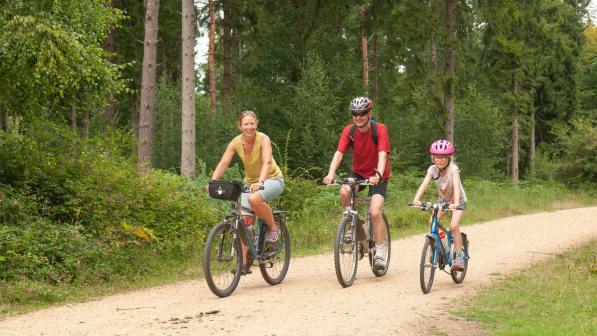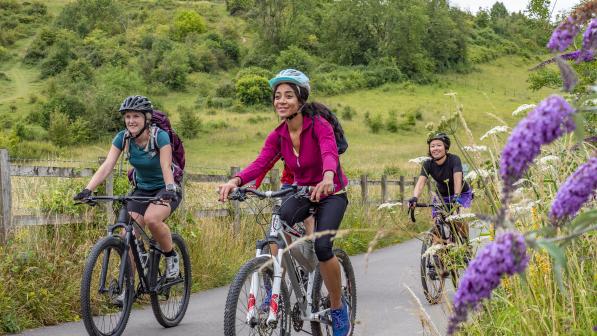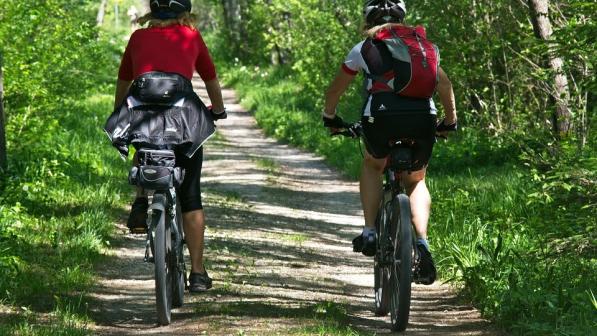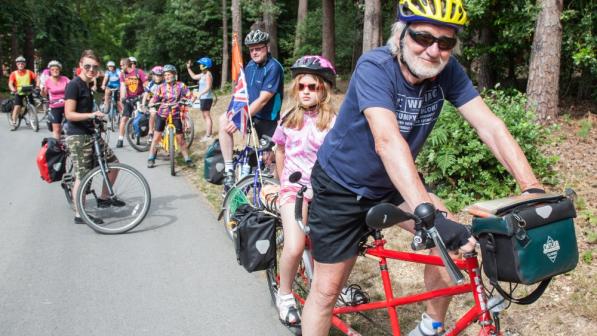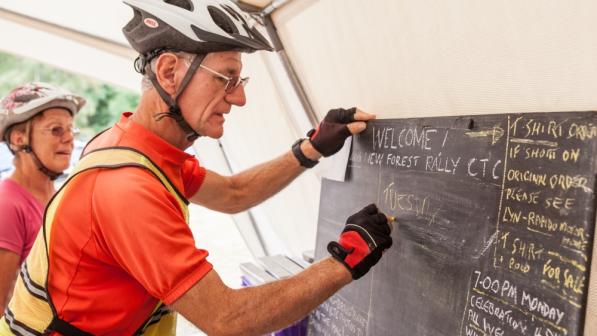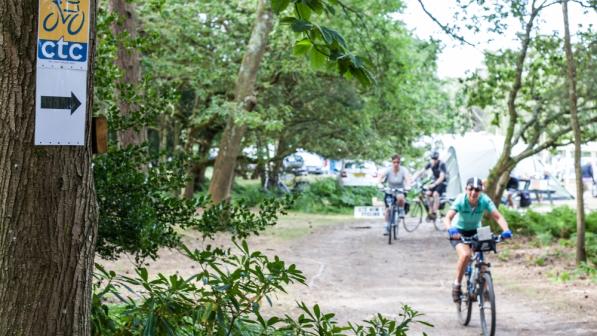New Forest: When is a National Park not a National Park?

It’s well known by now that the New Forest can be a hostile place for cyclists – if it’s not people scattering drawing pins on the road then it’s seeking to ban e-bikes, put number plates on riders and even being forced to hand back over a million pounds of sustainable transport funding after blocking proposals for a bike hire scheme.
But most recently, the Verderers of the New Forest have been making a fuss (again) over the issue of mountain biking, and the ‘lawlessness’ of cyclists riding off the permitted track network. In scenes increasingly reminiscent of a Python sketch, the Verderers have begun demanding that Forestry England (the landowners of most of the New Forest) enforce their byelaws (see sidebar) and prosecute wayward cyclists for their apparent crimes of despoiling nature and destroying the ‘tranquility’ of the Forest.
It's worth reminding ourselves that the New Forest is a National Park, with two dual purposes:
- Conserve and enhance the natural beauty, wildlife and cultural heritage
- Promote opportunities for the understanding and enjoyment of the special qualities of national parks by the public
These are supposed to be equally important, but the second purpose doesn’t seem to even come into play when we talk about cycling. So we have a bizarre situation where outside the National Park, riding somewhere you’re not supposed to counts as a civil trespass, but within its boundary, it becomes a criminal offence.
According to the Verderers, cycling anywhere beyond their network of ‘permitted routes’ is a criminal breach of the byelaws. However, this covers less than one third of the forest road network – gravel roads designed for the use of 44-ton timber wagons.
Now, nobody is calling for a free for all, or to allow cycling on highly sensitive heathland areas… but let’s have some sense here. There’s no logical or proportionate justification for banning cycles from Land Rover tracks and timber wagon routes – especially considering that walkers and horse riders have an unrestricted right of access to the whole of the New Forest.
To explain what’s going on, the existence of the Verderers of the New Forest may require a little introduction.
Who are the Verderers?
The Verderers have their origins in the historic ‘Courts of Swainmote’, a form of local judicial body set up to administer the King’s Forest in the aftermath of the Norman invasion.
Technically, the Verderers sit as a form of Magistrates’ court, and once upon a time offenders would have been prosecuted by the Verderers’ Court itself. However, more recent caselaw discusses how this is likely to conflict with the European Convention on Human Rights, as the court was acting as prosecutor, judge and recipient of any penalty. As a result, their status is more of a ceremonial forum for the airing of local grievances (‘presentments’), sort of like a parish council without any of the powers - but they still hold a lot of influence in local affairs, and they retain a number of important powers regarding the administration of the crown lands in the New Forest (land nowadays owned by the Secretary of State for the Environment, and managed on their behalf by the Forestry Commissioners).
The election of Verderers seems to owe more to the traditions of a gentleman’s club than any real semblance of local democracy. There are five elected Verderers, elected by the 700 local landowners with rights of common (rather than the 35,000 residents of the National Park, or the approximately 500,000 residents of the wider locality), plus an additional four Verderers appointed by public authorities. These are all led by a chief Verderer, currently Lord Manners (whose father, Lord Manners, was coincidentally also chief Verderer – what are the chances?)
This group of people then essentially get to decide what’s best for the forest and everyone who visits it. Obscure sections of the decades-old New Forest Acts, along with the Countryside Act 1968, give this (barely) elected body an essential veto over any development in the forest. Trumping almost entirely the ability of the National Park Authorities to fulfil the statutory purposes of the National Park.
Equal representation
Of course, commoning is an important – indeed vital – part of the culture and heritage, and the future, of the New Forest. The question is more whether a tiny minority of vested interests should have such a level of influence (a literal veto) on the administration and management of publicly owned land within a National Park – dedicated as such for the benefit of the nation, and without any real democratic accountability to the wider local community.
The current system of governance for National Parks should be reformed substantially
National Landscapes Review 2019
Anyone who has read the recent independent review of National Landscapes would see the issues here. Julian Glover discusses how:
“The current system of governance for National Parks (and, as we’ll explore later, AONBs) should be reformed substantially. Time after time we have heard and seen that National Park boards are too big, do not do a good job in setting a strategic direction and are deeply unrepresentative of England’s diverse communities. Of the almost 1,000 people on National Park and AONB boards today, the great majority are male, many are of retirement age and a tiny fraction are of black, Asian or minority ethnicities. This is wrong for organisations which are funded by the nation to serve everyone.”
If that’s true of National Park Authorities across England, then the message can only be magnified by the issues in the New Forest, where the restricted election mandate leads to such a tiny percentage of the local community electing a body with quasi-judicial functions and powers to control how public land is used for the benefit of the nation.
Of course, that also means that there are a whole stack of competing organisations with statutory authority regarding the New Forest: Forestry England, the Verderers, New Forest National Park Authority, New Forest District Council, Hampshire County Council, plus of course another thirty-seven parish and town councils. But for some reason, none of them seems to hold quite as much weight, or anywhere near as much as an opinion on the issue of cycling, as the Verderers.
‘Townies vs country folk’?
And make no mistake, this isn’t a ‘townies versus traditional country folk’ issue.
I myself am the epitome of that background: I grew up around farming and gamekeeping and went on to train in forest and wildlife management, but am also a lifelong keen mountain biker with a veritable lust for adventure and deeper connection with nature. In fact, when you get down to it, it’s arguable that many mountain bikers are much closer to ‘ramblers on wheels’, or at least hikers than the ‘Lycra lout’ fantasy that the Verderers and their friends seem so keen to obsess over.
So I do have sympathy to some of the concerns that have been elucidated by the Verderers over the potential impact of increased levels of recreation on wildlife and conservation, or on how more visitors might lead to increasing urbanisation of the countryside.
But I think the way these concerns are being targeted to blame and victimise a tiny proportion of the New Forest’s users (about 5% of visitors) is shameful.

Is cycling really the biggest threat?
The greatest impacts on the wildlife and habitat of the New Forest are from issues such as dogs off leads (around 30% of New Forest visitors, over five million visits a year, are for dog-walking) and from the ever-present automobile.
93% of visitors to the National Park arrive by car and in order to accommodate this, there are over 130 public car parks on Forestry England land within the New Forest.
The impact of this level of car use on the forest is considerable. Over 250 commoners’ animals (ponies, donkeys, cattle etc.) killed by motor vehicles over the past few years, plus deer collisions so numerous they stopped even recording them. Let’s not forget the deaths of seven pedestrians and cyclists (and over 100 seriously injured) by motor vehicles in the New Forest district over the same period. One crossroads alone witnessed a pattern of multiple cyclist fatalities and serious injuries that took years to rectify due to the complexity of New Forest issues.
Plus of course, the potential biggest threat to the future of the New Forest ecosystem: climate change, which is being fuelled by the means of transport that the majority of visitors and locals get around by. Meanwhile, the Verderers shortsightedly oppose plans for improved traffic-free access for cyclists that would connect the towns and villages across the area in a way that the current ‘permitted network’ simply does not.
No evidence of greater impact
So, it’s time to get a sense of proportion here and look again at what is really going on in the New Forest. This is a National Park – the purposes of which are to serve the diverse and varied communities of the whole society, not just the selected few. The Verderers publicly claim to be supportive of cycling, but in reality their long track record, and a perusal of the minutes of the Verderers meetings shows the levels of vitriol and hyperbole repeatedly resorted to when discussing any issues regarding cycling.
Now, that’s not to pretend that all cyclists are saints, or that off-road cycling and mountain biking don’t have any impact whatsoever – but despite years of requests, the Verderers and others have failed to present any evidence that the impact of bikes is of greater significance than that of walkers or horse riders, who have an unrestricted right of access across the entirety of the crown lands.
As such, the Verderers’ position, and stated policies, fly in the face of government policy around cycling, and against the well-established legal duties of all public sector bodies when it comes to National Parks – that they must give due regard to the dual purposes equally, and the first should only be given greater priority if there is evidence of irreconcilable conflict which cannot be managed. In this case, that evidence simply doesn’t exist.
In the National Landscapes review, Julian Glover commented that:
"We think there is a case for looking at whether further access rights should be established, or at the very least considered or trialled in our national landscapes. The existing law and its application excludes many different user groups entirely, or favours walking on foot. We do not seek to undermine those rights; indeed we want to see walking further supported by national landscapes taking on rights of way management and the National Landscapes Service supporting National Trails. But it feels wrong that many parts of our most beautiful places are off‐limits to horse riders, water users, cavers, wild campers and so on. We hope that as part of the government’s commitment to connect more people with nature, it will look seriously at whether the levels of open access we have in our most special places are adequate."
We can only agree. It’s time for change.
